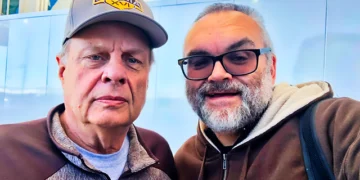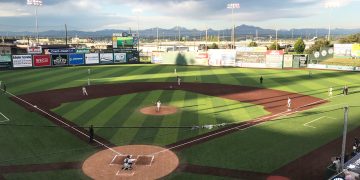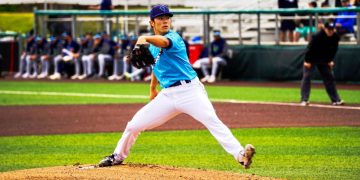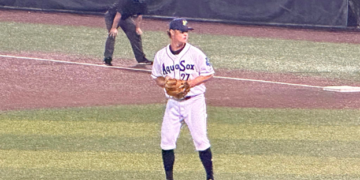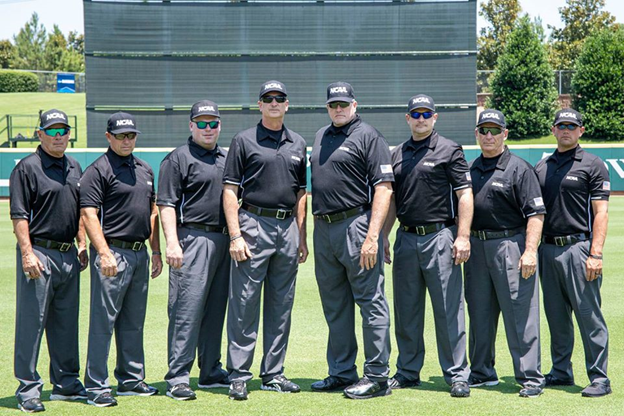(Photo Credit: Facebook)
Pre-COVID-19 the Seattle Sports Union (SSU) gang got to catch up with former baseball umpire and current umpire trainer Brian Hertzog about what it is like to have the weight of a game on his shoulder much less the wrath of the average Joe in the 15th row. Brian is the president and CEO of Official Business LLC.
Full disclosure, we at SSU have known Brian Hertzog for several years now having made acquaintance with him at Everett AquaSox games and following his career for several seasons now. Brian hosts trainings for aspiring umpires and we got a front row seat and the opportunity to ask a few questions. Join us as we begin our query. Our first query was to see if umpires worry about the bigger scale issues in the MLB like reducing the total minor league teams.
SSU: Are you worried about fewer umpires if the MLB reduces the minor league teams by 42 teams?
Brian: I know they are far along about talking about it but have not heard much about it.
It was enlightening to know that those issues are not as relevant as we the average fan tend to concern ourselves about. We moved into a discussion about how umpires elevate themselves from the minor leagues up to the majors.
SSU: Are umpires rated for various levels of the minors/majors?
Brian: Yes, you all funnel in at rookie ball and then you have a certain amount of evaluations. Every year a staff of instructors travel around to every league. Some are assigned to double A, some are assigned to single A. You are always evaluated at a level above you, so if you are in double A you get evaluated for the triple A umpires. I wouldn’t say you are rated for a certain level, but you are in a holding pattern and at the end of the year you are ranked at a certain level.
SSU: You mean ranked against other umpires?
Brian: Yes, I will use double A as an example, there are 45 umpires and you get ranked 1-45.
SSU: Is it like soccer where you get relegated to a different level?
Brian: No it is a retention policy. If you are at the bottom too long you will top out. Every 3 years is how long you have to get through a level. So, I spent 3 years at A ball, and it was an up or out decision at that point. I went up to double A spent 3 years there until they made the same decision about me there.
From there we found ourselves taken to a video room to see the breakdown of individual plays. And my gosh, there was more scrutiny over each and every individual element of the game than we, the average fan could ever expect. For example, there was a good 20 minutes focused on the intricacies of what exactly the “runner interference” truly is.
SSU: So I didn’t realize that there was so much that went into runner’s interference. A runner doesn’t just get to have the running lane when a batted ball comes into play.
Brian: From the 2nd to last World Series game, they were looking at that exact runner’s interference (scenario) as well–it was textbook. You don’t usually have the luxuries of just coming out of the runner’s lane. To exit the runner’s lane, you have to be in it. Just like to exit this box. I have to be in it to start. (But as a batted ball comes to a fielder) A runner thinks, well, that last step is mine type of thing. But if you were a foot or two over, you know, that ball was just a tiny bit off. It wasn’t that far off, especially knowinng the big leaguers. They can make those catches.
In this scenario, a runner had gone from 1st base to second base and may or may not have been blocking the umpires view.
SSU: Ok from the last two umpire scenarios, from what I saw. It looked a bit confusing what was going on. Who has what responsibility?
Brian: Yeah, that’s a good thing to break down for you right there. We have a runner on 1st, a catcher, a base umpire in the middle field—this is called the “B” position. “A” would be no runners on and he would be behind 1st. This is about us always staying ahead of the runner. So, when we have a base hit to the outfield with this runner on first, the plate umpire is going to be coming up to 3rd base to stay ahead of that runner from 1st. And, you know, we’re umpires, so it also goes without saying that we need a little extra room. I can’t run 90 feet in the same span that they can run 90 feet! So the home plate umpire covers 3rd because all he has to do is go from home to 3rd before the man on 1st gets to 3rd. Then it is just a matter of communicating with that B position if the runner rounds 3rd to go home.
Umpires are not just passive bystanders like we are in the stands, they have to calculate hundreds of possibilities and react to them properly. That is the goal of this training, to instill that programming, that repetition that it takes to build good habits.
SSU: And when you have the runner at 2nd?
Brian: I mean, you throw a runner on second base and we have less than two outs. And now you not only have base hits to think about, but now you have to know where your rotations are. You have, you know, pop fly to the outfield, tag up situations where your plate umpires coming up to third and saying, I got third. If he tags, which means the “B” knows his back is covered, which means he has to tag up at first base and to play into second.
But if the ball drops. That all falls apart. It is not a tag up situation like there’s just so many you know, there’s so many different scenarios. And you’re just looking at a runner on first base right now and the two umpires system. And it gets ugly. Not confusing necessarily, but it does get more complicated.
The idea that umpires’ rapport with each other are so highly developed was just fascinating. As a fan, we focus so much on the play that we don’t notice that there are (at this minor league level) just 2 umpires who have to watch all 4 bases.
SSU: So it must be easier with more umpires.
Brian: Well, actually it gets more complicated when you move to three umpires and then four umpires. You can’t do a 3 or 4 umpires system without having been in a 2 umpire system. We might have three umpires and the third base umpire goes out because there’s a shot to the gap that he might dive for. It will revert to the two umpire system. So, you have to you immediately know my umpires out and to revert back.
Brian Hertzog is one of the preeminent umpire trainers in the country. He doesn’t just do the rounds, he doesn’t just train his fellow umpire, he bridges the gap between umps and the leagues they serve. It was fascinating to just see the immense turnout of future umpires in attendance that day.
SSU: So is there a big turnout of umpires here?
Brian: Yeah. Hundred and thirty five was our number. It flexed a little bit. I think we lost a few, but we also gained like five Little League umpires last night. I got a call an old partner from A ball down in Centralia. I got a hold of him and he said “hey, I could only register for one on the website. I’ve got five Little League umpires. Can we just set them up in the morning.”
I was like, dude, just pay these associations in the morning. Bring them. We just kind of want to get as many out here as we can. The cool thing about this one for I think all of us is that are looking at multiple associations here. You see a NBUA Northwest Baseball Umpire Association, which is where I started with. Now and then SCBUA, Snohomish County Baseball Umpires Association, and then all the other online sign ups.
You know, there’s a couple from Skagit County, maybe one or two from Whatcom as well, a few from all the way down to Corvallis. One of the base umpires that’s a rookie ball guy is from Corvallis. He brought a few guys up because we would really like to expand this next year. We can pull a lot from Snohomish and Whatcom counties. One of the instructors out here is from Vancouver, B.C. so maybe some that some of that crowd. And then if we do the next one down in Tacoma or something like that, hopefully would draw a lot of the Portland crowd to be able to come up to it as well.
Brian’s business also included help from friends of his.
SSU: Is this expansion recent? And what led to it?
Brian: We’ve been trying to do that for a long time. And this, I think, mainly because we always want to have my Mike and Trip involved. You know, everyone. They’re just wonderful listening to talk.
I was very fortunate to be going through my second year in Triple A, Trip was my crew chief. I think that’s the year he got his first big job. And then, you know, this guy, Mike Muchlinski, he was in maybe double A at the time. By the time I get to triple-A, he’s still going up and down, about to get his full-time big job. But he came down and joined our crew.
SSU: So getting to work with Mike was helpful but getting to the Big leagues isn’t a quick process.
Brian: So, yeah, it was pretty special for me, starting in the association, sitting in this training, watching Mike you know, and he’s just in double A at the time and then go through the whole process and by the time I get the triple A.
But that’s also speaks to how long it takes to advance. People think just because I was in triple-A for three years, that I was quite close. And it’s like it looks so very close. But there are so many more steps because you got to get an invite to Arizona fall league. Then you have to get an invite to full time, like a full spring training schedule. From there, all the guys with spring training schedules are all fighting to just get a big league number assigned to them and then you just have a big league number assigned to you. It doesn’t mean you necessarily get your first game that year and you could just get a handful or something like that before you start.
SSU: It seems you build relationships then?
Brian: I like that aspect. When you have some of the coaches that you have a really good relationship or something like that, you just want to give him one of these (an amusing gesture) and they know we’re not so serious. Situations as in “we’re gonna go have an argument” type situations but we aren’t going to do that in this specific training. But when we do, it’s fun to give those coaches a little bit of leash, as they need to get through it; and then we can take him aside later and go down the list of things during the play, how to handle the situation afterwards. You know, it could’ve been something that was maybe a coaching point, the perfect opportunity for you to throw something in there that could have de-escalate it. It you know, that parts an art. It is good to read a book like “Verbal Judo” and de-escalate the situation.
The recurring theme throughout, was again that communication with your fellow umps was the key.
SSU: Wow, I didn’t know you guys communicate so much, wow, there’s a lot of it.
Brian: See and you get to know your partners like Danny. And this is hard for me getting back in college while I don’t communicate as much as I need to out of the field. We use very, very specific verbiage. And I don’t use a specific enough verbiage as I need to. Like, we just we know by looking at each other. You know, you get to know each other other’s strengths and weaknesses and now and such. So, I mean, that’s extremely helpful in getting to work with the same guy for an entire season.
SSU: And that is the point of the training right?
Brian: Yeah that’s why teaching these guys the exact verbiage is important. Because as the plate umpire is coming up, he’s saying, “I got 3rd if he comes.” If he then follows that up with “I got third, I got third.” That’s because he’ll stay up here. We call this the library just in between the coach’s box and the (3rd base) line here. Because he’s reading what’s going to happen next. He decided that no, that guy’s rounding third. I need to go back home if he bolts home.
If he then says, I got third. That means he’s got the ball. Come in third. He’s got the runner there and he’s got a fielder to catch it. And he’s going to get to the inside cut out right here to third base.
SSU: Oh look that exact thing just happened.
Brian: Yeah and it looks like we’ve got to correct that rotation (laughs). That’s also why you never want to even number of umpires on a call. I need someone to break the tie if that happens, you know (laughs). His instructor will take him off and just explain that. So what were our thoughts? Were you thinking first and second and your plate umpire was rotating up? Were you just having a brain fart? Did you not hear your partner? That could be something too, you know, maybe he wasn’t loud enough. And, you know, we’ll bring that up to him, too.
We of course had to ask the tough question to the rule that no one really understands.
SSU: Infield fly rule, whose call is it if there are 2 umpires?
Brian: It really is anyone’s call.
We as sports fans idolize the athletes and often forget the time, effort, blood, sweat, and tears put in by the boys (and girls) in blue who officiate this wonderful game. We at SSU appreciate the invite from Brian Hertzog and his group to his training. We hope to meet up with him again if/when the season starts up again.

